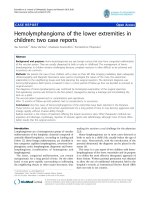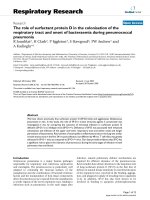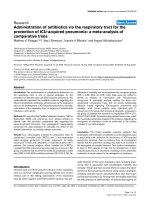Ebook Kendig''s disorders of the respiratory tract in children (9/E): Part 1
Bạn đang xem bản rút gọn của tài liệu. Xem và tải ngay bản đầy đủ của tài liệu tại đây (16.96 MB, 2,361 trang )
Kendig's
Disorders of the
Respiratory Tract
in Children
NINTH EDITION
Robert William Wilmott, BSc, MB,
BS, MD, FRCP (UK)
IMMUNO Professor and Chair
Department of Pediatrics
Saint Louis University
Pediatrician in Chief
SSM Cardinal Glennon Children's Medical Center
St. Louis, Missouri, United States
2
Robin Deterding, MD
Chief
Pediatric Pulmonary Medicine
Professor of Pediatrics
Department of Pediatrics
University of Colorado
Aurora, Colorado, United States
Albert Li, MBBch, MD, MRCPCH,
MRCP(UK), FHKAM(Paeds),
FHKCPaed
Assistant Dean (Education)
Faculty of Medicine
Professor of Paediatrics
Prince of Wales Hospital
The Chinese University of Hong Kong
Shatin, Hong Kong
Felix Ratjen, MD, PhD, FRCP(C),
FERS
Head
Division of Respiratory Medicine
Program Head
Translational Medicine
Sellers Chair of Cystic Fibrosis
Professor
University of Toronto
Hospital for Sick Children
Toronto, Ontario, Canada
3
Peter Sly, MBBS, MD, FRACP,
DSc
Director
Children's Lung Environment and Asthma Research Group
University of Queensland
Brisbane, Australia
Heather J. Zar, MBBCh, FCPaeds,
FRCP (Edinburgh), PhD
Professor and Chair
Department of Paediatrics & Child Health
Director MRC Unit on Child & Adolescent Health
Red Cross War Memorial Children's Hospital
University of Cape Town
Cape Town, South Africa
Andrew Bush, MB BS(Hons), MA,
MD, FRCP, FRCPCH, FERS
Professor of Paediatrics and Head of Section
Imperial College London
Professor of Paediatric Respirology
National Heart and Lung Institute
Consultant Paediatric Chest Physician
Royal Brompton Harefield NHS Foundation Trust
London, Great Britain
4
5
Table of Contents
Instructions for online access
Cover image
Title Page
Copyright
Preface
Contributors
Video Contents
Section 1 General Basic and Clinical Considerations
1 The History and Physical Examination
The History
The Physical Examination
6
Common Signs and Symptoms of Chest Disease in Children
Conclusion
Suggested Reading
2 Molecular Determinants of Lung Morphogenesis
Introduction
Organogenesis of the Lung
Molecular Mechanisms Directing Lung Development
Development of the Pulmonary Host Defense Systems
Gene Mutations in Lung Development and Function
Summary
References
3 Basic Genetics and Epigenetics of Childhood Lung Disease
Types of Genetic Variation
Technologies to Identify Genetic Variation
Interpretation of Genetic Variation
When to Consider Clinical Genetic Testing
Research Study Designs to Attribute Genetic Variation to Disease
Epigenetics—Terminology and Technology
“Multi-Omics” Approaches to Refine Genotype-Phenotype Associations
Websites
References
4 Environmental Contributions to Respiratory Disease in Children
7
Vulnerability of Children to Adverse Environmental Exposures
Environmental Contributions to Acute Respiratory Illness and
Pneumonia
Environmental Contributions to Asthma
Summary
References
5 The Surfactant System
Surfactant Composition and Metabolism
Surfactant Metabolism and Secretion
Alveolar Life Cycle of Surfactant
Surfactant Function
Pressure-Volume Curves
Host Defense Functions of Surfactant
Surfactant Deficiency
Surfactant Treatment of Surfactant Deficiency
References
6 The Structural and Physiologic Basis of Respiratory Disease
Normal Lung Anatomy and Cell Function
Airways
Alveolar Region
Pulmonary Vascular System
Lymphatic System
Innervation of the Lung
8
Interstitium
Growth and Development of the Lung
The Lung at Birth
Postnatal Lung Growth
Ventilation and Mechanics of Breathing
Definitions and Symbols
Elastic Recoil of the Lung
Compliance of the Lung
Elastic Properties of the Chest Wall
Lung Volumes
Regional Lung Volumes
Dynamic (Flow-Resistive) Properties of the Lung
Distribution of Ventilation
Pulmonary Circulation
Pulmonary Vascular Pressures
Pulmonary Vascular Resistance
Distribution of Blood Flow
Methods of Evaluating the Pulmonary Circulation
Muscles of Respiration
Gas Exchange
Alveolar Ventilation
Dead Space
Diffusion
Shunt and Ventilation-Perfusion Relationships
9
Systemic Gas Transport
Oxygen Therapy
Carbon Dioxide Transport and Acid-Base Balance
Tissue Respiration
Regulation of Respiration
Sensory Feedback System
Metabolic Functions of the Lung
References
7 Biology and Assessment of Airway Inflammation
Introduction
Allergic Inflammation
Acute Inflammation
Chronic Inflammation
Inflammatory Cells
Structural Cells as Sources of Mediators
Inflammatory Mediators
Neural Mechanisms
Transcription Factors
Antiinflammatory Mechanisms
Direct Measurements of Airway Inflammation
Noninvasive Assessment of Airway Inflammation
Is AHR an Inflammatory Surrogate?
Other Potential Indirect Inflammatory Markers
10
Is There a Role for Assessing Inflammation in Pediatric Respiratory
Disease?
Therapeutic Implications
Conclusion
References
8 Lung Defenses
Intrinsic Lung Defenses
Innate Lung Defenses
Adaptive Lung Defenses
Role of Programmed Cell Death and “Clearing the Garbage” in Lung
Homeostasis
Summary
References
9 Bronchoscopy and Bronchoalveolar Lavage in Pediatric Patients
Instrumentation
Techniques for Bronchoscopy
Anesthesia for Bronchoscopy
Indications for Diagnostic Bronchoscopy
Contraindications to Bronchoscopy
Bronchoalveolar Lavage
Diagnostic Techniques Other Than Bronchoalveolar Lavage
Therapeutic Bronchoscopy
Complications of Bronchoscopy
Economic Aspects of Bronchoscopy
11
References
10 Diagnostic Imaging of the Respiratory Tract
Plain Radiography
Specific Features of the Chest Radiograph in Children
Systematic Review of the Chest Radiograph
Fluoroscopic Techniques
Computed Tomography
Isotropic Computed Tomography
Data Processing
Review of Findings
Pitfalls
Radiation Dose
High-Resolution Computed Tomography
Controlled Ventilation Technique
Interpretation
Angiography
Magnetic Resonance Imaging
Endobronchial Ultrasonography
Ultrasonography
Radionuclide Imaging
Conclusion
References
11 Pulmonary Function Tests in Infants and Children
12
Introduction
Measurement of Lung Volumes
Measurement of Diffusing Capacity of Carbon Monoxide
Measurement of Forced Expiration
Measurement of Resistance and Compliance
Measurement of Gas Mixing
References
12 Exercise and Lung Function in Child Health and Disease
The Biological Importance of Physical Activity in the Growing Child
From the Playground to the Bench to the Physician's Office
Physiologic Response to Progressive Exercise Testing
The Challenge of Scaling Cardiopulmonary Exercise Testing to Body
Mass in Children and Adolescents and the Special Case of Obesity
Development of Physiological Responses to Exercise in Children and
Adolescents and Predicting Cardiopulmonary Health Across the
Lifespan
Searching for Normal Values in Pediatric Cardiopulmonary Exercise
Testing
Asthma and Exercise
Physical Activity, Exercise and Cystic Fibrosis
Physical Activity, Exercise, and Lung Disease of Prematurity
Exercise at Altitude in Child Health
High Altitude and Children With Chronic Lung Disease
Exercise and Laryngeal Obstruction
Toward the Future: Exercise in the Age of Omics
13
References
13 Integrating Patient-Reported Outcomes Into Research and
Clinical Practice
Definition of a Patient-Reported Outcome
Development and Utilization of Patient-Reported Outcomes
Health-Related Quality of Life Measures
Developmental Considerations
Use of Proxy-Respondents
Clinical Utility
Summary
Review of Disease-Specific Respiratory Health-Related Quality of Life
Measures
Conclusions and Future Directions
References
14 Transition From Pediatric to Adult Care
Introduction
What Is Transition?
Why Is Transition Important?
Transition: A Practical Approach
Barriers to Transition
Summary
References
15 Long-Term Consequences of Childhood Respiratory Disease
14
Introduction
How the Lung Develops in Health and Disease
The End-Stage—Chronic Obstructive Pulmonary Disease
Long-Term Consequences of Specific Diseases
Summary and Conclusions
References
16 Drug Administration by Inhalation in Children
Advantages and Disadvantages of Aerosols for Drug Delivery
What Is a Therapeutic Aerosol?
Principles of Aerosol Delivery
Assessment Techniques
Aerosol Devices
Dosage Considerations
Advice and Training for Parents
Progress Toward the Ideal Delivery System
References
17 Physical Therapies in Pediatric Respiratory Disease
General Principles of Physiotherapy
Role of Physiotherapy in Pediatric Respiratory Disease
Respiratory Physiotherapy in Specific Conditions
Conditions Not Generally Amenable to Physiotherapy
Summary
References
15
18 Congenital Lung Disease
Introduction
Clinical Approach
The Size of the Problem: Epidemiology of Congenital Malformations of
the Lung
Antenatal Diagnosis and Management of Congenital Lung Disease
Specific Diagnoses: Congenital Diaphragmatic Hernia
Specific Diagnoses: Upper Respiratory Tract Atresias
Specific Postnatal Problems: Congenital Abnormalities of the Upper
Airway
Examination of a Child Presenting in the Clinic Setting
The Emergent/Marginal Airway and Difficult Intubations
Extubation Difficulties/Failed Extubation
Congenital Abnormalities of the Larynx
Vocal Cord Paralysis
Congenital Abnormalities of the Trachea
Specific Problems: Congenital Bronchial Abnormalities
Specific Problems: Parenchymal Lesions
Specific Problems: Overexpansion, Aplasia and Ectopia
Specific Problems: Abnormal Connections Between the Bronchial Tree
and Other Structures
Specific Problems: Congenital Disease of the Pulmonary Arterial Tree
Specific Problems: Congenital Disease of the Pulmonary Venous Tree
Specific Problems: Abnormalities of the Connections Between the
Pulmonary Arterial and Venous Trees
Specific Problems: Congenital Disease of the Lymphatic Tree
16
Specific Problems: Congenital Disorders of the Chest Wall
Specific Problems: Congenital Cardiac Disorders
Specific Problems: Multisystem Congenital Disorders That Affect the
Lung
Role of Specific Investigations
Summary and Conclusions
References
19 Respiratory Disorders in the Newborn
Initiation of Respiration at Birth
Fetal Lung Fluid
Respiratory Depression at Birth
Delivery Room Resuscitation
Ventilatory Control
Respiratory Distress Syndrome
Transient Tachypnea of the Newborn
Meconium Aspiration Syndrome
Acute Respiratory Distress Syndrome
Early-Onset Pneumonia
Late-Onset Pneumonia
Aspiration Pneumonia
Interstitial Lung Disease
Persistent Pulmonary Hypertension of the Newborn
Pulmonary Hypertension in Bronchopulmonary Dysplasia
Pneumothorax
17
Pneumomediastinum
Pneumopericardium
Pulmonary Interstitial Emphysema
Secondary Pulmonary Hypoplasia
Patent Ductus Arteriosus
Pulmonary Edema
Pulmonary Hemorrhage
Upper Airway Obstruction
Gastroesophageal Reflux
References
20 Bronchopulmonary Dysplasia
Introduction
Definition
Epidemiology
Etiology
Pathogenesis
Pathophysiology
Clinical Findings
Prevention
Treatment
Prognosis
Summary
References
18
21 Children Dependent on Respiratory Technology
Introduction
Epidemiology
Goals of Therapy
General Considerations for Home Care
Treatment of Chronic Respiratory Failure
Ancillary Equipment
Patient Follow-Up
Outcomes
Summary
References
Section 2 Infections of the Lung
22 Microbiological Diagnosis of Respiratory Illness
Respiratory Pathogens and Syndromes
Use of the Clinical Microbiology Laboratory
Microbiome
Future Prospects
References
23 Acute Infections That Produce Upper Airway Obstruction
Viral Laryngotracheobronchitis
Diagnosis and Differential Diagnosis
19
Epiglottitis
Bacterial Tracheitis
Diphtheria
Retropharyngeal Abscess
Peritonsillar Abscess (Quinsy)
Infectious Mononucleosis
References
24 Bronchiolitis
Epidemiology
Etiology
Pathology/Pathogenesis
Clinical Features
Diagnosis and Differential Diagnosis
Management and Treatment
Prevention
Prognosis
References
25 Pneumonia in Children
Epidemiology and Etiology
Pathogenesis
Clinical Features
Etiologic Diagnosis
Diagnosis and Differential Diagnosis
20
General Management
Treatment With Antimicrobials
Slowly Resolving Pneumonia
Major Clinical Complications
Prevention
Prognosis
References
26 Bronchiectasis and Chronic Suppurative Lung Disease
Introduction
Definitions
Bronchiectasis and Chronic Suppurative Lung Disease
Protracted Bacterial Bronchitis
References
27 Influenza
Introduction
Epidemiology
Pathology/Pathogenesis
Clinical Features
Diagnosis and Differential Diagnosis
Management and Treatment
Prevention
Prognosis/Outcome
References
21
28 New and Emerging Infections of the Lung
Introduction
Middle East Respiratory Syndrome Coronavirus
Human Metapneumovirus
Rhinovirus C
Adenovirus
References
29 Tuberculosis
Epidemiology
Mycobacteriology
Immunology
Pathophysiology
Clinical Features
Diagnosis
Tests of Infection
Laboratory Diagnosis
Treatment
Control and Prevention
References
30 Nontuberculosis Mycobacterial Disease
Microbiology
Epidemiology
Acquisition and Potential for Transmission
22
Apparent Increase in Nontuberculous Mycobacteria Vulnerable
Populations and in the Modern Environment
Clinical Manifestations of Nontuberculous Mycobacteria Pulmonary
Disease
Diagnosis of Nontuberculous Mycobacteria Pulmonary Disease
Management and Treatment
Outcomes
References
31 The Pulmonary Mycoses
Introduction
Antifungal Drugs
Endemic Mycoses
Pulmonary Mycoses Primarily Seen in Hosts With Impaired Immunity
References
32 Pertussis and Other Bordetella Infections of the Respiratory Tract
Epidemiology
Etiology
Pathology/Pathogenesis
Clinical Features
Imaging, Pulmonary Function Testing, Laboratory Findings
Diagnosis and Differential Diagnosis
Management and Treatment
Prevention
Prognosis
23
References
33 Toxocariasis, Hydatid Disease of the Lung, Strongyloidiasis, and
Pulmonary Paragonimiasis
Toxocariasis
Echinococcosis (Hydatid Disease)
Strongyloidiasis
Pulmonary Paragonimiasis (Lung Fluke Disease)
References
Section 3 Pulmonary Disease in the Intensive Care
Unit
34 Principles of Mechanical Ventilation
History
Indications for Mechanical Ventilation
Composition of a Mechanical Ventilator
Modes of Ventilation
Noninvasive Ventilation
High-Frequency Ventilation
Neurally Adjusted Ventilator Assistance
Hemodynamic Effects of Mechanical Ventilation
Mechanical Ventilation in Specific Conditions
Management During Mechanical Ventilation
Complications of Mechanical Ventilation
24
Conclusion
References
35 Childhood Pulmonary Arterial Hypertension
Introduction
Definition and Classification
Epidemiology and Etiology
Neonatal Pulmonary Hypertension
Associated Pulmonary Arterial Hypertension With Congenital Heart
Disease
Management
Oxygen
Additional Pharmacotherapy: Cardiac Glycosides, Diuretics,
Antiarrhythmic Therapy, Inotropic Agents, and Nitrates
Atrial Septostomy
Lung Transplantation
Conclusions
References
36 Pulmonary Edema
Anatomic Considerations
Factors Responsible for Fluid Movement
Mechanisms That Cause Pulmonary Edema
Clearance of Pulmonary Edema Fluid
Pathophysiologic Consequences of Edema
Clinical Presentation
25









